Question 1: Let and
be the two subset of the universal set
. Draw the Venn diagrams to represent these sets. From the Venn diagrams so drawn, find: (i)
(ii)
(iii)
(iv)
Answer:

Question 2. From the Adjoining figure, find: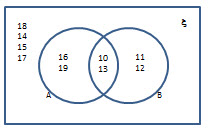
(i) (ii)
(iii)
(iv) (v)
(vi)
Answer:
(i)
Note: Take the common elements between and
(ii)
Note: Take all the elements from the universal set which are not in and
(iii)
Note: All elements that are in the universal set but not in
(iv)
Note: All elements that are in the universal set but not in
(v)
Note: All elements that are in the universal set but not in
(vi)
Note: All elements that are in the universal set but not in
Question 3: Use the adjoining figure, find the following: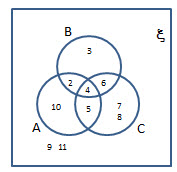
(i) (ii)
(iii)
(iv)
(v )
(vi)
(vii)
(viii)
(ix)
(x)
(xi)
(xii)
Answers:
(i) (ii)
(iii)
(iv) (v)
(vi)
(vii) (vii)
(ix)
(x) (xi)
(xii)
Question 4. Use the adjacent Venn diagram to find: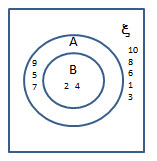
(i) (ii)
(iii)
(iv)
(v)
(vi)
Answers:
(i) (ii)
(iii)
Note: There are no elements in which are not in
. Hence Null set.
(iv) (v)
(vi)
Question 5: Let and
be sets such that
,
and
. Draw Venn diagrams and find:
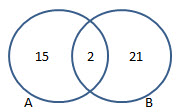
(i) (ii)
(iii)
Answers:
(i)
Note: Elements which are in but not in
(ii)
Note: Total number of elements in which are
(iii)
Note: Elements which are in but not in
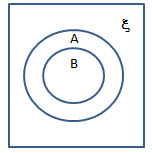 Question 6: In the adjoining figure,
Question 6: In the adjoining figure, and
are two sets of the universal set
such that
,
,
and
. Find: (i)
(ii)
(iii)
Answers:
(i) (ii)
(iii)
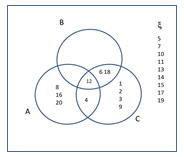 Question 7: If
Question 7: If ,
,
and
. Draw a Venn diagram to show that the relationship between the given sets
(i) (ii)
(iii)
Answer:
The first step is to identify the elements of all the sets. They would be as below:
Now it is easy to calculate the following:
(i) (ii)
(iii)
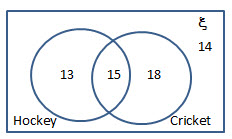 Question 8. In a class of
Question 8. In a class of pupils,
play hockey,
play cricket and
play none of these games. Draw the Venn diagram to find:
(i) How many play both games
(ii) How many play hockey only
(iii) How many play cricket only
Answer:
(i)
(ii)
(iii)
(iv)
Question 9: In a club, three-tenths of its members play cards only and four-tenths play carom only. If members play none of these games and
play both, find using Venn diagram, the total number of members in the club.
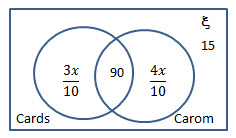 Answer:
Answer:
Let the total no. of members
Question 10: In a colony, two-fifths of the families read the newspaper, “Times of India” and three-fourth of the families read “Hindustan Times”. If families read none of these two newspaper and
families read both, use Venn diagram to find the number of families in the colony.
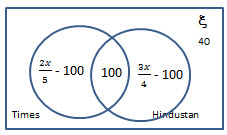
Answer:
Now calculate the equation: Let be the number of families
Hence
Question 11: In a class of boys,
like horror movies,
like war movies, and
like neither. Find the number of those who like both.
Answer: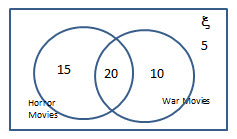
Question 12: In a group of persons, each one knows either Hindi or Tamil. If persons know Hindi,
know Tamil, and
know both, how many people are there in all, in the group?
Answer: Total number of people in the group
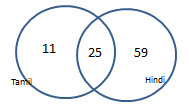
Question 13: In a certain locality of Delhi there are families. A survey showed that
subscribe to “The Hindustan Times” newspaper and
subscribe to “The Times of India” newspaper and
subscribe to both. Find the number of families that do not subscribe to any of these newspapers.
Answer:
Number of families which do not subscribe to any of these newspapers
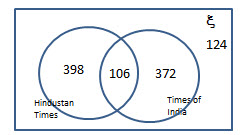

thank you for your help